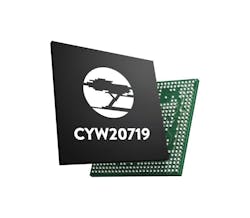Download this article in PDF format.
Selecting a wireless technology for your next design is a challenging task. With over a dozen standards to consider, you need a strong rationale to choose amongst them. Two factors stand out when making this choice. First, Bluetooth has been around for over two decades and experienced continuous growth, enhancement, support, and adoption. Second, because it’s so ubiquitous, Bluetooth has proven itself to work reliably in many situations. Bluetooth may ultimately be your solution.
Sponsored Resources:
- The Industry's Broadest IoT Bluetooth® Module Portfolio
- Cypress Semiconductor's fully certified Bluetooth 5.0 module based on the CYW20719 dual-mode Bluetooth SoC
- Cypress Semiconductor's fully certified Bluetooth 5.0 module based on the CYW20707 dual-mode Bluetooth SoC
Bluetooth is Everywhere
Literally billions of electronic products today contain a Bluetooth IC. Haven’t we all had to “pair” some Bluetooth devices? Here are just a few of the places where you will find Bluetooth:
- Smartphones
- Tablets
- PCs
- PC peripherals
- Wireless speakers
- Headsets and headphones
- Hearing aids
- Auto hands-off systems
- Smart-home applications
- Sports and fitness watches
- Toys
- Industrial sensors
Analyzing that list shows that if audio is involved, Bluetooth is the way to go. And it’s also a prime candidate for new Internet of Things (IoT) and Industry 4.0 applications thanks to the Bluetooth Low Energy (BLE) version.
What Version of Bluetooth Do You Need?
Two recent versions are Bluetooth 5.0 and BLE. The 5.0 version is the full standard that’s an extension of the Bluetooth Classic Basic Rate/Enhanced Data Rate (BR/EDR) versions. BLE is designed mainly for low-power IoT applications. The table gives a brief summary of the key features and specifications.
Some Bluetooth ICs and modules offer dual-mode operation. Dual mode refers to a chip or module that can handle BR and EDR specs of the older standard but also work with BLE. There are multiple sources of Bluetooth chips and modules to choose from, and all offer models with on-board MCUs with analog-to-digital converters (ADCs).
Make vs. Buy Decision
If you’ve decided on Bluetooth, the next step is to determine if you will design the product in-house or buy as much as you can from available sources. This decision is based on your RF design talent as well as your budget.
RF design capability refers to those who can layout an RF PCB; design the antenna, transmission line, and matching circuits; and perform the required certification testing. Your antenna choices are usually a chip antenna that mounts on the same PCB as the Bluetooth IC or a PCB antenna. A PCB antenna is etched into the copper on the PCB. This is a tricky design and typically requires several iterations of PCB layout to optimize performance. For long-range applications, an outside gain antenna may be needed.
Another consideration is that all wireless products to be sold commercially must be certified by the FCC. You can do it yourself if you know how and have all the right test equipment. You can also have the certification conducted by an outside vendor that specializes in that service. The cost can be more than $10,000 for a non-module product. That’s usually less expensive than buying the test equipment.
An alternative approach is to use an available Bluetooth module. Everything is contained within a small package that you can simply drop into your product and, voilà, instant Bluetooth connectivity. The benefits of this approach are faster time to market and little or no RF knowledge needed. And the good news is that modules are pre-certified, eliminating that cost. The main downside is the higher cost of the modules and the possible lack of the availability of a module that physically and electronically fits into your product.
Selecting a Module
If your decision is to use a module, you must find the best one for your application. There are multiple module suppliers. One way to identify the best product for you is to go to a source with multiple options. For instance, Cypress Semiconductor is a vendor that provides a very broad Bluetooth Module portfolio. The company offers modules ideal for almost any design need, such as small module footprint, extended operating temperature, cost-optimization, or long-range communication. Cypress’s Bluetooth Modules are fully certified, fully integrated, programmable, and available in dual-mode and BLE-only versions.
Cypress also offers the Wireless Internet Connectivity for Embedded Devices (WICED), an IoT design platform and software development kit (SDK) that supports the Bluetooth modules.
In addition, Cypress and its distributor Digi-Key provide tools to help you zero in on a module that best fits your design. One of these tools includes the following categories: Cost, Size, Need for External Antenna, Extended Range, Extended Temperature plus Extended Range. Suitable modules are suggested for each category.
Another tool organizes their available modules another way—the end application is chosen first. Categories include Smart Home, Industrial, Medical Health Fitness, Beacons and Tags, Toys and Accessories. These categories are further assisted by additional classification, such as: Need for full dual-mode Bluetooth 5.0, mesh network support, extended range, extended temperature range, antenna type, size and form factor, capacitive sensing, and cost.
Some Example Modules
Cypress's dual-mode Bluetooth 5.0 module is a fully integrated Bluetooth BR/EDR and Low Energy (BLE) wireless module. It’s based on the CYW20719 dual-mode Bluetooth SoC (see figure) and is compatible with the company’s WICED Studio SDK. This module comes in a small form-factor and is well-suited for IoT applications requiring mesh support, long-range connectivity, low-power, and LE 2M PHY.
Cypress’s CYW20719 SoC is a dual-mode device that supports legacy Bluetooth BR/EDR and Bluetooth Low Energy versions.
Another ultra-small form-factor Bluetooth 5.0 module from Cypress, the CYBT-353027-02, is a fully integrated Bluetooth Smart-ready wireless module. It’s based on the CYW20707 dual-mode Bluetooth SoC and is compatible with Cypress' WICE® Studio SDK. CYBT-353027-02 supports peripheral functions (ADC, timers), UART, I2C, and SPI communication, and has a Bluetooth audio interface. Also supported is a royalty-free BLE stack compatible with Bluetooth 5.0. CYBT-353027-02 comes in an industry-leading small form-factor (9.00 mm x 9.00 mm x 1.75 mm) to enable space-constrained IoT applications.
Sponsored Resources:
- The Industry's Broadest IoT Bluetooth® Module Portfolio
- Cypress Semiconductor's fully certified Bluetooth 5.0 module based on the CYW20719 dual-mode Bluetooth SoC
- Cypress Semiconductor's fully certified Bluetooth 5.0 module based on the CYW20707 dual-mode Bluetooth SoC
Related References:


